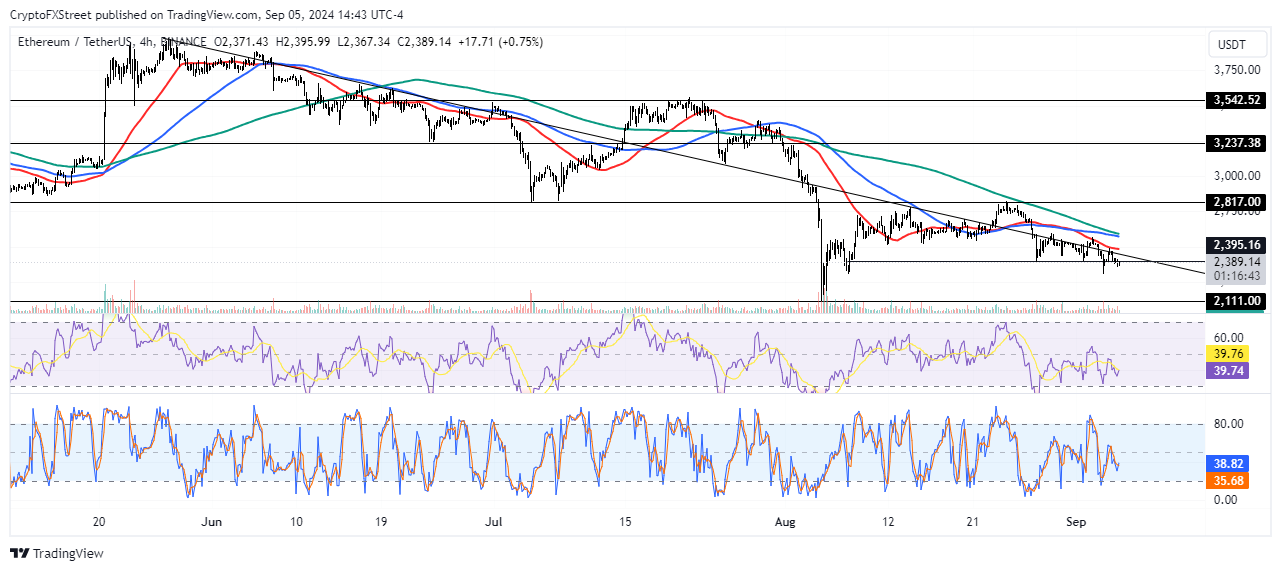- Ethereum has underperformed key assets within and outside the crypto market.
- Ethereum is an innovation at the level of human civilization but is mispriced due to lack of killer applications, says F2pool co-founder.
- Ethereum could decline toward $2,111 if it fails to reclaim the $2,400 support level.
Ethereum (ETH) is down 2% on Thursday following a key analysis showing the top altcoin has underperformed assets, including Bitcoin, Solana, Nvidia, Meta, Apple, Gold and others. CryptoQuant analysts and the F2pool co-founder weigh in on why ETH has underperformed and what investors should expect.
Daily digest market movers: Is Ethereum underperforming or undervalued?
According to Ecoinometrics, Ethereum has been the worst-performing asset among large capitalization assets year to date. While Nvidia, Meta, Bitcoin, Apple, Gold, Google, Amazon, NASDAQ and Microsoft have posted gains of 142%, 48%, 38%, 22%, 19%, 18%, 18% and 12%, respectively, Ethereum struggles with a return of only 9%.
The fall outlook isn’t great, more downside risk:
• Small rate cuts probably won’t boost market liquidity much.
• U.S. economic uncertainty may weaken the broader market.Now is a time for caution rather than bold moves.
Follow @ecoinometrics for more charts and insights on…
— ecoinometrics (@ecoinometrics) September 5, 2024
Following anticipation of Ethereum’s The Merge second anniversary marking the transition to a proof-of-stake consensus mechanism, CryptoQuant’s analysts noted that the top altcoin struggles began after the event. According to the analysts, Ethereum has underperformed Bitcoin, Solana and BNB by 44%, 53% and 18%, respectively, since The Merge.
CryptoQuant analysts noted that some key reasons for the underperformance include a lower total transaction count in the Mainnet, which caused a decline in transaction fees. Additionally, Ethereum’s supply has been rising and may not hold its deflationary status again. The analysts attributed the rising supply and weak network activity to the Dencun upgrade in March, which introduced new architectural dynamics in Ethereum.
Considering the FUD following ETH’s underperformance, Shenyu, co-founder of F2pool, noted that Ethereum is still an innovation at the level of human civilization, and the market underestimates its value because killer applications have not yet emerged.
“As investors, we must tolerate this kind of mispricing and volatility in order to get real returns,” said Shenyu.
Meanwhile, Ethereum ETFs recorded a second consecutive day of negative flows with net outflows of $37.5 million. Grayscale’s ETHE posted outflows of $40.6 million, while its Mini Ethereum Trust saw inflows of $3.1 million.
ETH technical analysis: Ethereum could see further decline if it fails to reclaim key support level
Ethereum is trading around $2,390 on Thursday, down more than 2% on the day. In the past 24 hours, ETH has seen $14.74 million in liquidations, with long and short liquidations accounting for $11.09 million and $3.65 million, respectively.
ETH has breached the support level around $2,400 of a key rectangle for the second time in the past three days. ETH traded inside this rectangle for over three weeks in August before moving outside it on Tuesday.

ETH/USDT 4-hour chart
If ETH fails to quickly reclaim the $2,400 support, its price could decline toward the $2,111 support level. This aligns with a key trendline that suggests ETH will likely decline to the support level around $2,111 before staging a rally.
The Relative Strength Index (RSI) is below its midline but attempting to move above its moving average. If it completes this move, ETH could see a brief rise.
In the short term, ETH could rise to $2,425 to liquidate positions worth more than $45 million.
Ethereum FAQs
Ethereum is a decentralized open-source blockchain with smart contracts functionality. Serving as the basal network for the Ether (ETH) cryptocurrency, it is the second largest crypto and largest altcoin by market capitalization. The Ethereum network is tailored for scalability, programmability, security, and decentralization, attributes that make it popular among developers.
Ethereum uses decentralized blockchain technology, where developers can build and deploy applications that are independent of the central authority. To make this easier, the network has a programming language in place, which helps users create self-executing smart contracts. A smart contract is basically a code that can be verified and allows inter-user transactions.
Staking is a process where investors grow their portfolios by locking their assets for a specified duration instead of selling them. It is used by most blockchains, especially the ones that employ Proof-of-Stake (PoS) mechanism, with users earning rewards as an incentive for committing their tokens. For most long-term cryptocurrency holders, staking is a strategy to make passive income from your assets, putting them to work in exchange for reward generation.
Ethereum transitioned from a Proof-of-Work (PoW) to a Proof-of-Stake (PoS) mechanism in an event christened “The Merge.” The transformation came as the network wanted to achieve more security, cut down on energy consumption by 99.95%, and execute new scaling solutions with a possible threshold of 100,000 transactions per second. With PoS, there are less entry barriers for miners considering the reduced energy demands.

























